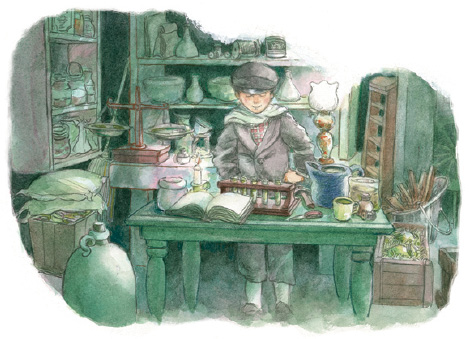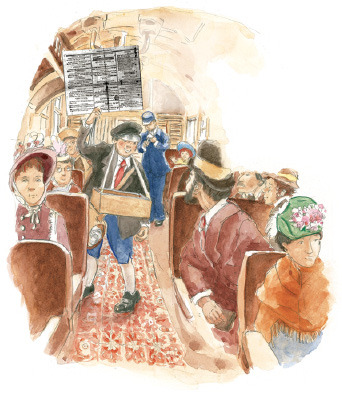Chapter One
A Boy Who Couldn’t Learn

His teacher called him “addled” and said that he had something wrong with his brain and would never be able to learn. It was true that young Thomas Alva Edison didn’t want to sit still in his one-room schoolhouse classroom and learn the way that the other students learned. He would rather draw in his notebook instead of copying down assignments. He had more questions than the teacher wanted to answer, and he didn’t like to sit still. To make things worse, young Little Al (short for Alva, as his parents called him) was often sick and was already losing his hearing, which made it even harder for him to pay attention in the classroom. Mr. Crawford, his teacher, made fun of him and often sent him to sit in the corner as a punishment.
For many kids, this would have turned them off from learning. But young Thomas Edison, who had been born on February 11, 1847, was no ordinary kid. His mother, Nancy, saw this clearly, and when Al came home in tears, telling her what the teacher had said about his ability to learn, she became very, very angry. A former schoolteacher herself, she pulled him out of Mr. Crawford’s school and decided that she would teach him herself, at home. As Edison later said, “My mother was the making of me. She was so true, so sure of me.”
Suddenly the boy who couldn’t learn was devouring books on his own, as fast as he could read them, and then using his curiosity and energy to explore the places around his home in Port Huron, Michigan. There were so many questions in his head that young Edison wanted to answer. He became interested in science and machines, and how the world worked. He wondered if eating like a bird would make it possible for him to fly, so he tried eating a concoction of mashed-up worms…only to end up with nothing more than an upset stomach. He collected so many things, such as animal bones and feathers, that his mother finally urged him to set up his own laboratory in the basement. He built little machines, such as cannon and water mills, and experimented with chemicals, even though his mother warned him about the dangers of mixing them.
Al was restless, though, and soon he needed even more distractions to keep him occupied. His home was just a few blocks away from the Port Huron train station, and the trains that came and went all day long fascinated Al. Eventually his father helped him get a job on one of the trains that ran every day between Port Huron and Detroit. Even though he was only 12, Al began working as a “news butch,” selling things such as newspapers, candy, books, and even fresh vegetables to the passengers on the train. It was a three-hour trip each way, and, in between trips, Edison would spend his time reading in a Detroit library. He later wrote that it was the “happiest time of my life.” He even wrote and printed his own newspaper, the Herald, which he sold on the train for 3 cents a copy. It was probably the very first newspaper to be printed on a moving train.

He also set up a small laboratory in the baggage car of the train, where he could work on his experiments. Unfortunately, this came to an end one day when he accidentally set the car on fire when a bottle of phosphorus fell off a shelf. Edison found himself thrown off the train at the next station by the angry conductor, along with all his laboratory equipment. Despite this accident, he did manage to keep his job. But young Al was getting restless again. He was also losing more of his hearing. Years later he would say that he hadn’t heard a bird sing since he was 12 years old. But he also found that his increasing deafness actually made it easier for him to concentrate on the many things that appealed to his curiosity.
It would be an act of bravery that gave Edison his next opportunity, and one that paved the way for the inventor he would become. Edison, who now preferred to be called Tom instead of Al, was fascinated by the telegraph, the first machine that allowed people to communicate with each other over long distances simply by using a series of short and long clicks in Morse code. J.U. Mackenzie was the stationmaster at the Mount Clemons train station, where Tom liked to spend time. He let Tom listen to the telegraph wires and taught him about what was then a brand new technology.
One morning Tom was talking with Mackenzie when he noticed that Mackenzie’s three-year-old son was playing on the railroad tracks, right in the path of an oncoming train. Tom quickly moved in and scooped up the little boy to safety. Neither of them was hurt. Mackenzie was so grateful that he offered to teach Tom everything about running the telegraph. A few months later, Tom was able to get a job as a telegraph operator. The Civil War had begun, and there was heavy traffic on the telegraph wires with reports from the battlefronts and lists of casualties. For several years, Tom Edison moved around frequently, finding different telegraph jobs in different parts of Michigan and nearby states as well. He liked working at night, which gave him time to read. About this time he also started sleeping less, a habit that he would eventually become famous for. Sleeping only a few hours a night gave him more time to work. Edison finally found himself working in Boston, Massachusetts, in a much busier telegraph office. But he was already starting to become restless again, and soon Thomas Edison, telegraph operator, would start to become Thomas Edison, inventor.